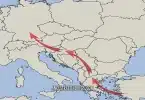When your family first came to the United States, it was likely an exciting time. Somehow, over the years, the history of where your family came from was lost. Never fear, because, with the use of naturalization records, you can start to retrace your ancestor’s steps. By starting with naturalization records, you take the least you know about your relative, which may be a name and where they lived, and begin to backtrack from there. The naturalization record itself can give you a surprising amount of information for a fairly small time investment, so it’s a good place to start when you’re first beginning to research your family history.
What Are Naturalization Records?
Before the year 1906, it was possible for aliens, or people coming from other countries, to be naturalized in any court in the United States. Those being naturalized were primarily immigrants who wanted to start the process for citizenship as soon as they arrived in the country. When these immigrants arrived, they’d go through a process of naturalization; they would often take American names and move to where they wanted to live.
The problem with naturalization records is that the immigrants may have started the process in the county where they arrived, but then they moved. Completing citizenship in another part of the country means that the records are spread out in many cases.
It wasn’t until 1906 that Immigration and Naturalization Services, or the INS, was created. At that point, it was known by various other names, but the agency’s goals were the same. The service provided a standardized form no matter where the foreign nationals arrived in the country. Naturalization papers’ copies were collected at various ports and were sent to the INS for record keeping.
What Can a Naturalization Record Tell You?
Naturalization records have a vast amount of information key to your search for your family’s history. For instance, these papers may include the immigrants’ original family names, their Americanized names, the nation of origin, the current residency, and the date of arrival.
Before 1906, naturalization records may have contained alternative information like the port of arrival, the date of arrival, the age of the immigrant who arrived, the origin of the immigrant, and the residence of the immigrant. In times Pre-1790, immigrants were primarily British and were automatically named citizens of the British Empire’s colonies. During colonial times, there were three kinds of naturalization including an oath of allegiance, collective citizenship, and denization. Collective citizenship is the most difficult for people to research because this was when an entire group of people was naturalized without any documentation.
After 1906, it’s common to find information such as:
- The port of arrival
- The immigrant’s place of birth and birth date
- The date of arrival
- The way the immigrant arrived (IE: boat, plane)
- The occupation of the immigrant
- A physical description of the immigrant
- Information on the immigrant’s spouse and/or children
- The date of marriage, if the immigrant was married
- Marital status
- The last known foreign address
- The age of the immigrant
- The location of the immigrant’s residence
Because the requirements of naturalization have changed over the years, it’s not uncommon to find that varying records were kept.
How Can Naturalization Records Be Accessed?
There are various ways to access naturalization records, but one of the best is to look by time period. For instance, the Passenger and Immigration Lists Index by William P. Filby as records from between the 1500s and 1900s. between 1607 and 1775, on the other hand, Denizations and Naturalizations in the British Colonies in America by Lloyd deWitt Bockstruck would be a better research material.
For records between the years 1790 and 1906, it’s best to look for naturalization records in the state or local courts in the area where your ancestor lived. If your family moved often, then you may need to search each individual location for additional naturalization information. Start by looking at where the immigrant settled, because that’s most likely to be where you’ll find the petition for naturalization.
Since 1906, the naturalization process has been regulated. The Bureau of Immigration and Naturalization, now known as the United States Citizenship and Immigration Services, collected copies of naturalization records throughout that time.
Immigrants filed a Declaration of Intent, known as Form 2202, and completed it in triplicate for the court, themselves, and the Bureau. If your family still possesses documents such as the Declaration of Intent, then the naturalization process may never have been completed, since this was required to start the process.
Because of this process being more regulated, you should be able to contact any court that still completes naturalizations for information about your ancestors.
What Should You Do If You’re Having Trouble Finding Naturalization Records?
If you’ve been searching courts where your ancestor lived and aren’t having any success, consider looking where your ancestor worked. For example, if your ancestor lived in Cleveland but was working in Hudson, then the Hudson court would potentially have more information or the naturalization records you’re looking for.
You can contact the United States Citizenship and Immigration Services (USCIS) directly or access their records online by going to USCIS.gov.
Another place to try is your Family History Library or FamilySearch.org. It has records by state, state and county, or state, county, and town. Depending on how much information you have already, this can be a breakthrough search.
Naturalization records can be the first place you start when you’re looking for your family history. Whether it’s a history from the 1600s or you want to look up a more recent relative, the USCIS or these research materials can help.






